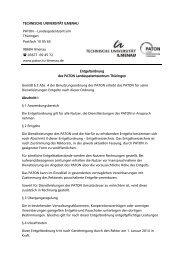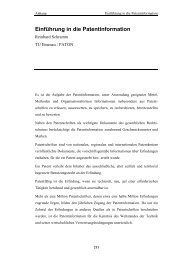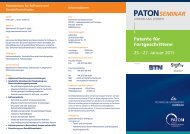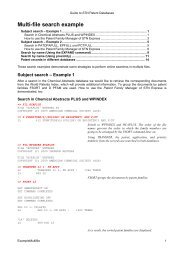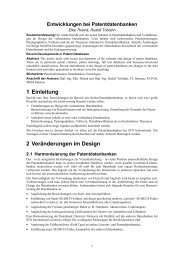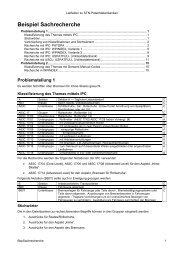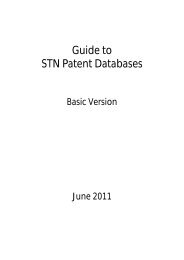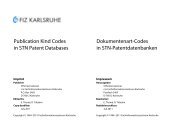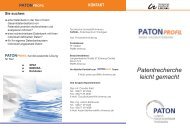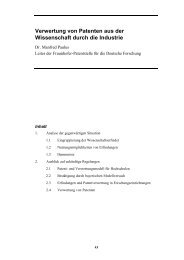Guide to STN Patent Databases – Basic Version - Paton - TU Ilmenau
Guide to STN Patent Databases – Basic Version - Paton - TU Ilmenau
Guide to STN Patent Databases – Basic Version - Paton - TU Ilmenau
Create successful ePaper yourself
Turn your PDF publications into a flip-book with our unique Google optimized e-Paper software.
9.3 Contents<br />
54<br />
<strong>Guide</strong> <strong>to</strong> <strong>STN</strong> <strong>Patent</strong> <strong>Databases</strong><br />
Publications in respect of national and international patent and utility model specifications (~90+ national<br />
and regional patent offices, EPO, WIPO)<br />
DWPI<br />
Database coverage before 1968: since 1836 (US), 1840 (GB), 1879 (DE), 1900 (FR), 1944 (JP)<br />
Bibliographical details<br />
International <strong>Patent</strong> Classification IPC1 8, online thesaurus incl. catchwords, range searching possible,<br />
re-classification of the back-file<br />
<strong>Patent</strong> family details<br />
Legal status details:<br />
Countries with legal status information: AT, AU, BE, BR, CA, CH, CN, CO, CS, CU, CZ, DD, DE, DK, EE, EP,<br />
ES, FI, FR, GB, HK, HU, IE, IL, IT, LT, LU, MC, MD, NL, NO, NZ, PH, PL, PT, RU, SE, SI, SK, TW, US, WO<br />
Entry of PCT applications in<strong>to</strong> the national stage: AT, AU, BE, BG, BR, BY, BZ, CA, CH, CN, CZ, DE, EA, EG,<br />
ES, FI, GB, GE, HR, HU, IL, JP, KE, KR, LI (über CH), LT, LV, MD, MX, MY, NZ, PH, PL, RO, RU, SE, SI, SK, US,<br />
UZ, WO, ZA ZA<br />
Non-entry of PCT applications in<strong>to</strong> the national stage: CA, DE, JP, KR<br />
Entry of EP patents in<strong>to</strong> the national stage: BE, CH, CY, DK, EP, ES, FR, GB, GR, HK (EP,CN), IE, IT, LI, LT, LU,<br />
NL, RO, SE, SI, TR<br />
SPCs (Supplementary Protection Certificates): AT, AU, BE, BR, CH, CN, CZ, DE, DK, EE, EP, ES, FI, FR, GB,<br />
HU, IT, IL, IT, LU, NL, NO, SE, SK, US<br />
Start of coverage varies by country, new countries are constantly added<br />
European <strong>Patent</strong> Classification (ECLA), online thesaurus, range searchable; other European classifications:<br />
ICO, IDT<br />
National classifications: AT, BR, CA, ES, GB, MX, NL<br />
National US Classification with thesaurus, Locarno Classification for US Design <strong>Patent</strong>s (since 04/2005)<br />
Japanese FI- and FTERMS (from1966) with thesaurus<br />
Partly abstracts (31 million) of 50 countries from 1970: e.g. US, GB (from 1897), WO, EP, CA, DE, KR, JP, FR,<br />
CN; an English equivalent abstract ABEQ from the simple patent family is displayed in the ALL and MAX<br />
display formats if no English abstract is available for a given publication (since update week 200740)<br />
<strong>Patent</strong> citations from 23 countries<br />
First page images are available for the following patent authorities: CH (1978-), DE (1970-), EP (1978-), FR<br />
(1969-), GB (1969-), JP (1980-), US (1971-), and WO (1978-)<br />
INPAFAMDB: display of the PI patent family information plus hyperlinks <strong>to</strong> the full-text documents (PDF) in<br />
Espacenet (PI.PDF)<br />
INPADOCDB is the most comprehensive patent database with regard <strong>to</strong> the countries covered. It corresponds <strong>to</strong> the<br />
<strong>Patent</strong> Family Service (PFS) and the legal status information of the <strong>Patent</strong> Register Service (PRS). The database is<br />
updated weekly with approx. 70,000 <strong>to</strong> 1,000,000 entries/updates of the bibliographical PFS and approx. 40,000 <strong>to</strong><br />
180,000 legal status entries in the PRS. The EPO receives the data from the patent offices or patent organisations in<br />
electronic or paper form. The EPO tries <strong>to</strong> standardise the data, but relies on the quality of the data provided. The<br />
data are in the original language, but partly (e.g. for Russian or Japanese publications) an English translation (titles)<br />
and/or transliteration (Names) is given. (For some countries (in particular JP), published applications (code JP-A2)<br />
are often entered without details of title, assignee and inven<strong>to</strong>r. As soon as such details are available, they are<br />
added <strong>to</strong> the record.)<br />
Using the priority information, documents belonging <strong>to</strong> the same patent family can be grouped <strong>to</strong>gether in<br />
INPADOC. This is particularly useful <strong>to</strong> find out whether an equivalent <strong>to</strong> a known document exists in another



